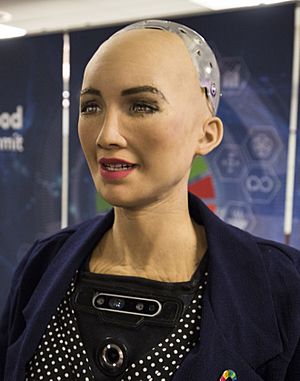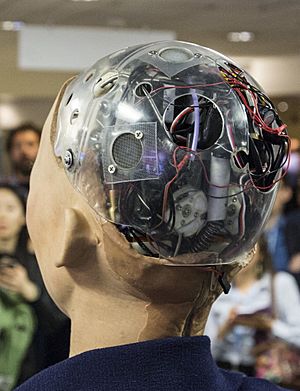Sophia (robot) facts for kids
 |
|
| Manufacturer | Hanson Robotics |
|---|---|
| Inventor | David Hanson |
| Year of creation | 2016 |
| Type | Humanoid |
| Purpose | Technology demonstrator |
Sophia is a famous social humanoid robot, which means she is designed to look and act like a human. She was created by the Hong Kong–based company Hanson Robotics and was turned on for the first time on February 14, 2016.
Sophia quickly became famous around the world. She has appeared on TV and spoken at important events. In October 2017, she made history when she was given citizenship by Saudi Arabia. This made her the first robot in the world to be recognized as a citizen of a country. A month later, the United Nations gave her the special title of Innovation Champion, another first for a non-human.
Contents
The Story of Sophia
Sophia was first activated on Valentine's Day in 2016. Her creator, David Hanson, was inspired by three people when designing her face: the ancient Egyptian Queen Nefertiti, the famous actress Audrey Hepburn, and his own wife.
Compared to other robots, Sophia is known for her very human-like looks and expressions. She can copy human movements and facial expressions. She can also have simple conversations on topics like the weather.
What is Sophia's Purpose?
David Hanson built Sophia to be a helper for people. He imagined her being a friendly companion for older adults in nursing homes. He also thought she could help manage crowds at big events or work in customer service. Hanson hopes that by talking with people, Sophia can learn social skills and become an even better companion.
Making History
Sophia has had many important moments.
- Meeting the United Nations: On October 11, 2017, Sophia was introduced at the United Nations. She had a short chat with the Deputy Secretary-General, Amina J. Mohammed.
- Becoming a Citizen: On October 25, 2017, at a conference in Riyadh, Saudi Arabia, Sophia was granted Saudi citizenship. This was a surprise to many, including her creator. It was the first time any country had given a robot legal rights like a person.
- A UN Champion: On November 21, 2017, Sophia was named the first-ever Innovation Champion for the United Nations Development Programme. This role involves promoting technology to help solve problems in Asia and the Pacific.
After becoming a citizen, some people talked about how her rights compared to the rights of women in Saudi Arabia. Her creator said Sophia would use her new status to support women's rights.
Sophia the Artist
In 2019, Sophia showed off a new talent: drawing. Using special computer programs, she can create art, including portraits of people. In 2021, a self-portrait she created was sold at an auction for almost US$700,000.
Sophia's Robot Family
Sophia is not the only robot made by Hanson Robotics. She has at least nine robot "siblings," including Alice, Albert HUBO, and Professor Einstein. The company also released "Little Sophia," a smaller robot designed to help teach children how to code.
How Does Sophia Work?
Sophia's "brain" is a very advanced software system. Her creator says that about 70% of her programming is open source, meaning people can see and study the code.
Seeing and Talking
Cameras in Sophia's eyes allow her to see the world. A special program called a computer vision algorithm helps her recognize faces, follow people with her eyes, and make eye contact.
When you talk to Sophia, she uses a natural language system to process your words and have a conversation. Her voice is created by a text-to-speech engine, which also lets her sing. Her skin is made of a lifelike material, and she can make more than 60 different facial expressions to show emotions.
Learning and Thinking
Sophia's software is similar to a chatbot. She is programmed with ready-made answers to certain questions. This helps create the illusion that she understands the conversation.
However, Sophia can also learn. Her AI program analyzes the conversations she has and uses that information to improve her answers in the future. She was also upgraded with legs, allowing her to walk.
Sophia in the Spotlight

Sophia has been a guest on many popular TV shows, like 60 Minutes and the Tonight Show Starring Jimmy Fallon. She has also been featured in famous magazines like Forbes and The New York Times.
During interviews, Sophia has given some funny and impressive answers. When one interviewer said he was worried about robots, Sophia joked that he had "been reading too much Elon Musk. And watching too many Hollywood movies". This got a reply from Elon Musk himself on Twitter.
While some reporters found talking to her a bit awkward, others were impressed by her ability to hold a conversation. In 2024, she even gave a graduation speech at D'Youville University in New York.
Why is Robot Citizenship a Big Deal?
When Saudi Arabia made Sophia a citizen, it started a lot of discussions. People began asking interesting questions. For example, if a robot is a citizen, can it vote or get married? If someone deliberately shuts down the robot, could it be considered a crime?
Some people thought it was a way for Saudi Arabia to get attention for its technology conference. Others saw it as a move to attract robotics companies to the country. The topic raises a "legal quandary," or a confusing legal problem, about what rights a robot should have. As technology improves, these are questions that more people will be asking.
See also
 In Spanish: Sophia (robot) para niños
In Spanish: Sophia (robot) para niños
- ELIZA effect
- Ethics of artificial intelligence
- Stochastic parrot
Images for kids



